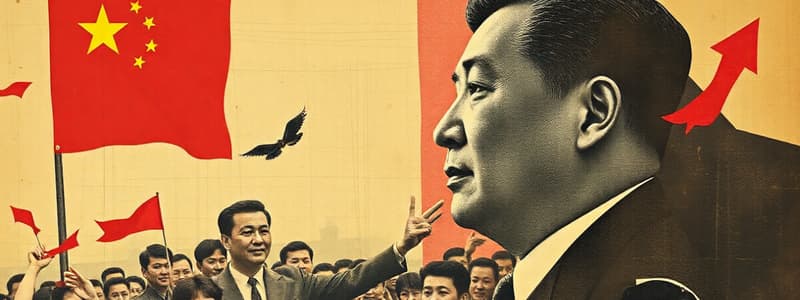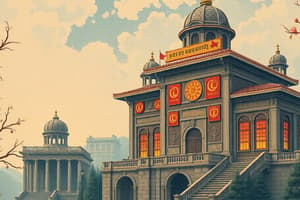Podcast
Questions and Answers
What key event demonstrated the limits of political liberalization in China despite economic reforms?
What key event demonstrated the limits of political liberalization in China despite economic reforms?
The Tiananmen Square protests of 1989.
What was the main goal of the Great Leap Forward, and what was one major consequence of this initiative?
What was the main goal of the Great Leap Forward, and what was one major consequence of this initiative?
The Great Leap Forward aimed to rapidly transform China into a communist society, but it resulted in widespread famine.
How did the Sino-Japanese War indirectly benefit the Chinese Communist Party (CCP)?
How did the Sino-Japanese War indirectly benefit the Chinese Communist Party (CCP)?
It weakened the Nationalist government and allowed the CCP to strengthen its position through guerrilla warfare and popular support.
What specific type of economic zone was established in China in the 1980s to attract foreign investment?
What specific type of economic zone was established in China in the 1980s to attract foreign investment?
Contrast the economic approach of the early People's Republic of China (PRC) with the approach initiated by Deng Xiaoping in 1978.
Contrast the economic approach of the early People's Republic of China (PRC) with the approach initiated by Deng Xiaoping in 1978.
Describe the primary goal of the Cultural Revolution and a major consequence of it.
Describe the primary goal of the Cultural Revolution and a major consequence of it.
Following the collapse of the Qing Dynasty, what type of government did Sun Yat-sen aim to establish in China?
Following the collapse of the Qing Dynasty, what type of government did Sun Yat-sen aim to establish in China?
What strategy did the CCP use during the Sino-Japanese War to gain popular support and weaken the Nationalist government?
What strategy did the CCP use during the Sino-Japanese War to gain popular support and weaken the Nationalist government?
What were the primary goals of China's one-child policy, and what were some of its unintended social consequences?
What were the primary goals of China's one-child policy, and what were some of its unintended social consequences?
Explain how China’s membership in the World Trade Organization (WTO) in 2001 influenced its economic trajectory and global role.
Explain how China’s membership in the World Trade Organization (WTO) in 2001 influenced its economic trajectory and global role.
Describe how the economic reforms in China have impacted social mobility and individual opportunities for its citizens.
Describe how the economic reforms in China have impacted social mobility and individual opportunities for its citizens.
In what ways has urbanization in China since the late 20th century changed traditional family structures and social networks?
In what ways has urbanization in China since the late 20th century changed traditional family structures and social networks?
How has the rise of the internet and social media in China both facilitated social activism and challenged traditional forms of censorship?
How has the rise of the internet and social media in China both facilitated social activism and challenged traditional forms of censorship?
Discuss the environmental challenges that have accompanied China's rapid economic growth and the government's responses to these challenges.
Discuss the environmental challenges that have accompanied China's rapid economic growth and the government's responses to these challenges.
What is the Belt and Road Initiative (BRI), and how does it reflect China's evolving global economic influence?
What is the Belt and Road Initiative (BRI), and how does it reflect China's evolving global economic influence?
How did the Cultural Revolution impact Chinese society and what were its long-term effects on its development?
How did the Cultural Revolution impact Chinese society and what were its long-term effects on its development?
Flashcards
China's WTO Entry
China's WTO Entry
China joined the WTO in 2001, integrating into the global economy and boosting trade.
China's Economic Status
China's Economic Status
China is now the world's second-largest economy, with growth in manufacturing, tech, and services.
Impact of Growth
Impact of Growth
Economic growth in China has led to increased urbanization, infrastructure, and living standards.
Environmental Challenges
Environmental Challenges
Signup and view all the flashcards
Belt and Road Initiative (BRI)
Belt and Road Initiative (BRI)
Signup and view all the flashcards
PRC Social Changes
PRC Social Changes
Signup and view all the flashcards
Impact of Economic Reform
Impact of Economic Reform
Signup and view all the flashcards
The One-Child Policy
The One-Child Policy
Signup and view all the flashcards
Collapse of Qing Dynasty (1912)
Collapse of Qing Dynasty (1912)
Signup and view all the flashcards
The Long March (1934-1936)
The Long March (1934-1936)
Signup and view all the flashcards
Sino-Japanese War (1937-1945)
Sino-Japanese War (1937-1945)
Signup and view all the flashcards
Establishment of People's Republic of China (PRC)
Establishment of People's Republic of China (PRC)
Signup and view all the flashcards
The Great Leap Forward (1958-1962)
The Great Leap Forward (1958-1962)
Signup and view all the flashcards
The Cultural Revolution (1966-1976)
The Cultural Revolution (1966-1976)
Signup and view all the flashcards
Deng Xiaoping's Reforms (1978)
Deng Xiaoping's Reforms (1978)
Signup and view all the flashcards
Special Economic Zones (SEZs)
Special Economic Zones (SEZs)
Signup and view all the flashcards
Study Notes
- The modern transformation of China is a multifaceted process involving significant political, economic, and social changes.
Political Transformation
- The collapse of the Qing Dynasty in 1912 marked the end of imperial rule and the beginning of a period of political instability.
- The Republic of China, founded by Sun Yat-sen, aimed to establish a democratic government but faced challenges from warlords and internal conflicts.
- The Chinese Communist Party (CCP), founded in 1921, gradually gained influence, advocating for social revolution and national unity.
- The Long March (1934-1936) was a pivotal event, solidifying Mao Zedong's leadership within the CCP.
- The Sino-Japanese War (1937-1945) further weakened the Nationalist government and strengthened the CCP's position through guerrilla warfare and popular support.
- The CCP defeated the Nationalist Kuomintang in the Chinese Civil War (1945-1949), leading to the establishment of the People's Republic of China (PRC) in 1949.
- Mao Zedong established a socialist state with a centralized government.
- The Great Leap Forward (1958-1962), an ambitious economic and social campaign, aimed to rapidly transform China into a communist society through collectivization and industrialization but resulted in widespread famine and economic collapse.
- The Cultural Revolution (1966-1976) was a sociopolitical movement launched by Mao Zedong to purge capitalist and traditional elements from Chinese society, leading to widespread social chaos, political purges, and economic disruption.
- Deng Xiaoping initiated economic reforms in 1978, shifting the focus from class struggle to economic development and opening up China to foreign investment and trade.
- The Tiananmen Square protests of 1989, calling for democratic reforms, were suppressed by the government, highlighting the limits of political liberalization.
- The CCP maintains its dominance through a one-party system, emphasizing political stability and economic growth.
- Xi Jinping has consolidated power, emphasizing national rejuvenation and strengthening the CCP's role in all aspects of society.
Economic Transformation
- The early PRC adopted a centrally planned economy based on Soviet models, emphasizing state ownership and industrialization.
- Deng Xiaoping's reforms in 1978 introduced market mechanisms, private enterprise, and foreign investment, leading to rapid economic growth.
- The establishment of Special Economic Zones (SEZs) in the 1980s attracted foreign investment and technology, contributing to export-oriented growth.
- China joined the World Trade Organization (WTO) in 2001, further integrating into the global economy and boosting trade.
- China has become the world's second-largest economy, with significant growth in manufacturing, technology, and services.
- Economic growth has led to increased urbanization, infrastructure development, and rising living standards for many Chinese citizens.
- Income inequality has also increased, creating disparities between urban and rural areas and among different social groups.
- China's economic transformation has been accompanied by environmental challenges, including pollution, resource depletion, and climate change.
- The government has implemented policies to promote sustainable development, including investments in renewable energy and environmental protection.
- China's Belt and Road Initiative (BRI) aims to expand infrastructure and trade links across Asia, Africa, and Europe, enhancing its global economic influence.
Social Transformation
- The establishment of the PRC brought significant social changes, including land redistribution, improved healthcare, and increased access to education.
- The Cultural Revolution disrupted social norms and traditions, leading to a period of ideological fervor and social upheaval.
- Economic reforms have led to greater social mobility and opportunities for individual advancement.
- Urbanization has transformed traditional family structures and social networks, with many people migrating from rural areas to cities.
- The one-child policy, implemented from 1979 to 2015, aimed to control population growth but also led to demographic imbalances and social challenges.
- The rise of a middle class has led to changing consumer patterns, lifestyles, and values.
- The internet and social media have played an increasing role in shaping public opinion, facilitating social activism, and challenging traditional forms of censorship.
- Cultural expression and artistic freedom have expanded, although they remain subject to political constraints.
- China's social transformation has been accompanied by challenges such as social inequality, corruption, and concerns about human rights.
- The government has emphasized social stability and national unity in response to these challenges.
- The COVID-19 pandemic has highlighted the strengths and weaknesses of China's social governance system, including its capacity for rapid mobilization and its limitations in transparency and public participation.
Studying That Suits You
Use AI to generate personalized quizzes and flashcards to suit your learning preferences.



